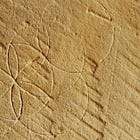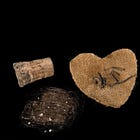Issue 52: a witch’s cauldron
A brief history of folk medicine and the story of a unique museum artifact.
Without a lot of individual database searching (there are about 1,800 accredited museums in the UK, and maybe as many as 2,500 in total!), I can’t tell you for sure how many others there might be. But I know there is at least one – in the collection of the Royal Albert Memorial Museum & Art Gallery (RAMM) in Exeter, southwest England.
That is: a cauldron with exquisite provenance linking it to a witch. A specific, named witch.
Elizabeth Webb, who was born around 1841 and died in 1913, was known as ‘The White Witch of Dartmoor’.
That’s how the folklorist Theo Brown (1914-1993) describes her in several papers she published throughout the second half of the 20th Century. It was Brown who donated the cauldron to the museum, having been given it by Webb’s grandson, William (1902-1967).

Now, before I go any further – in the interests of telling a balanced story – it’s important to point out that historian Owen Davies (who specialises in the history of magic), says there’s not really any such thing as a white, or any other coloured, witch.
In his 1998 paper, ‘Charmers and Charming in England and Wales from the 18th to 20th Century’, he explains:
“Like several other West Country writers on folklore, [Brown] adopted the three-type categorisation of witches delineated by the antiquarian John Brand. […] ‘White witches’ who use their powers to do good; ‘black witches’ who acted for purely maleficent reasons; and ‘grey witches’ who were a mixture of white and black […] I believe the use of colour epithets was a misleading – though simple and convenient – way to describe magical practitioners in educated discourse. [...] I have come across very few examples of these colour epithets being used within the popular discourse, either in the West Country or anywhere else, and have certainly not come across any instances of the term ‘grey witch’.”
But what Davies and Brown agree on – witch moniker or no – is that Webb’s activities match the description of a ‘charmer’.
What is a charmer?
Charmers were an important part of folk medicine, and according to Davies, remained in demand in parts of the UK until the 1970s. They didn’t diagnose ailments but could cure injuries resulting from accidents (such as bleeding, burns, and snake bites) or natural conditions (such as ringworm, toothache, and warts).
Their manner of healing generally fell into three categories: written or oral charms, an innate healing touch, and/or an ‘object-charm’ which had healing properties. They sometimes also dabbled in herbal remedies, and it is here where there is a cross over with witches, or ‘cunning folk’.
In 'Tales of a Dartmoor Village', published in the Devonshire Association’s ‘Transactions’ number xciii in 1961, Brown says: “The gift of charming remains a consistently more successful method with some diseases than all the doctor’s medicine.”
Charmers could be men or women, but their gift for healing was said to be passed on from a family member (or sometimes a close friend) of the opposite sex.
When employed, charmers’ occupations tended to be rural vocations related to the land.
Who was Elizabeth Webb?
As best I can track down, our Elizabeth Webb was born Elizabeth Anderson and married Thomas Webb in 1861. The couple are recorded in both the 1881 and 1901 census. Thomas is listed first as a tin miner and then as a farmer (there is no occupation – not even a tick in the ‘working at home’ box – for Elizabeth in either census).
In the RAMM’s description of the cauldron – which matches details from Brown’s published articles – they call Webb a “powerful charmer”.
“She could arrest bleeding at a distance without needing to see the patient. She grew herbs in her garden and used reeds from the marsh to cure warts. To cure snake bites, she would kill an adder, chop it up finely and cook it. When cool she would skim off the scum and make the patient drink it.”
In a 1970 paper called ‘Charming in Devon’, Brown describes how Webb, called upon to stop bleeding, “to the panting messenger at her door she would say ‘Yu go right back, me love, an’ yu’ll find it all stopped’ – and so it would be”.
In 'Tales of a Dartmoor Village', Brown reveals another of Webb’s healing recipes, for whooping cough: “catch a house-mouse, well fry it and eat it”.
Elizabeth and Thomas Webb had five children. Their youngest, John (who died at Flanders in WWI), married Elizabeth Westaway and they too had five children, one of whom was William Webb.
William (or Bill), Brown says, “inherited the charm for arresting haemorrhage from his celebrated grandmother”. He also inherited her cauldron.
The rarity of a provenancial cauldron
And so, to my opening statement: is the cauldron of a named witch charmer as exciting – as rare – to the museum sector as it seems to me?
Coincidentally, a new data service to bring together the object records of the UK’s museums was announced last week, but unfortunately it comes too late (or too early, depending on how you look at it) to be helpful for this story.
However, Holly, a curator at the RAMM, says: “I'm not sure if there are other cauldrons with a similar provenance – we don't have any in RAMM's collection. I would suspect that it’s quite rare and the connection to this specific cauldron has remained due to it being relatively modern.”
Related
You might also be interested in:
And finally…
We’ve heard that charmers can dispense their gifts from a distance. In his ‘Charmers and Charming’ paper, Davies says that by the 1950s, when telephones had become widespread, some charmers would offer cures over the phone. He recounts an amusing tale from that period:
“[A]n official inspecting a farm near Bridport, Dorset, was surprised to see a cow being led backwards out of the farmhouse. It transpired that the cow had redwater [a blood disease caused by ticks], and that they had asked the charmer to come and cure it, but the charmer was ill in bed, so the cow was taken to the telephone to hear the charm.”







